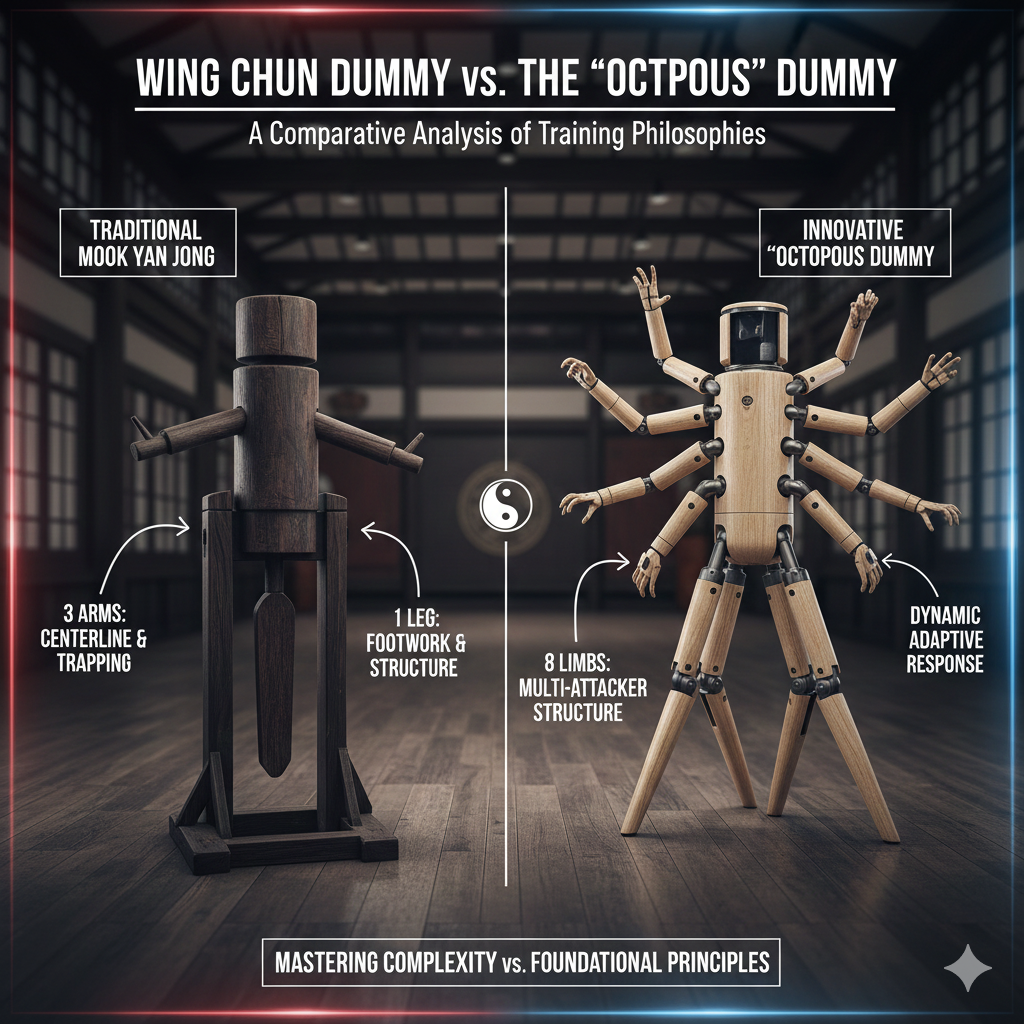Welcome – This blog is about martial arts but we wanted to share the best tips with you guys on CPR.
May be one day you will need to have things mind or ideas.
But with this post and practice at home, you can learn to practice.
Also we have shared some videos that will give you more knowledge.
Let’s get started —- Practice CPR Without a Dummy.
Cardiopulmonary Resuscitation, commonly known as CPR,
is an emergency procedure designed to restore breathing and blood circulation in individuals experiencing cardiac arrest or respiratory failure.
This life-saving technique involves a combination of chest compressions and artificial ventilation.
Aiming to preserve brain function until further medical help arrives.
The significance of CPR cannot be overstated.
as it serves as a critical intervention in emergency situations where immediate and decisive action can mean the difference between life and death.
Statistics underscore the life-saving potential of CPR.
According to the American Heart Association (AHA), approximately 475,000 people die from cardiac arrest in the United States each year.
However, the survival rate can significantly improve when bystanders administer CPR promptly.
Studies indicate that effective CPR, performed immediately after cardiac arrest, can double or even triple a victim’s chance of survival.
These numbers highlight the importance of widespread CPR training and preparedness in our communities.
Proper CPR training equips individuals with the necessary skills to act confidently and efficiently in emergencies.
While professional medical personnel are often the first responders, the initial moments following a cardiac arrest are crucial.
Laypersons trained in CPR can bridge the gap until professional help arrives, thereby enhancing the likelihood of a positive outcome.
Training programs typically cover various scenarios, including adult, child, and infant CPR, as well as the use of automated external defibrillators (AEDs).
Common scenarios where CPR might be necessary include drowning, choking, drug overdoses, and sudden cardiac events.
By understanding and mastering the principles of CPR, individuals can be prepared to respond effectively in these critical moments.
The importance of this knowledge extends beyond personal preparedness.
It fosters a sense of responsibility and empowerment, enabling individuals to contribute to the safety and well-being of their communities.
So let’s gets into – Practice CPR Without a Dummy.
Understanding the Basics of CPR
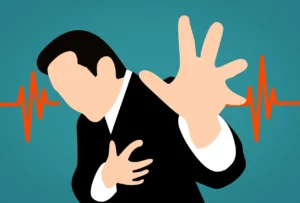
Cardiopulmonary resuscitation (CPR) is a life-saving technique that is essential in emergencies such as cardiac arrest.
The fundamental steps of performing CPR involve a series of chest compressions and rescue breaths.
Aimed at maintaining circulation and oxygenation in a person whose heart has stopped beating.
Understanding these basics is crucial, whether you are practicing CPR on a dummy or without one.
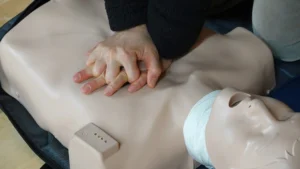
Correct hand placement is critical when performing CPR.
For adults, place the heel of one hand on the center of the chest, specifically on the lower half of the sternum, then place the other hand on top, interlocking your fingers.
Ensure your elbows are locked, and your shoulders are directly above your hands to apply adequate pressure.
For children, use one hand in the same position, and for infants, use two fingers placed just below the nipple line.
The depth of chest compressions also varies based on age.
For adults, compress the chest at least 2 inches deep, ensuring full recoil between compressions.
For children, aim for about 2 inches, and for infants, compress about 1.5 inches.
It is crucial to maintain a steady rhythm, with compressions delivered at a rate of 100 to 120 per minute.
The compression-to-breath ratio is another essential aspect.
For adults, it is typically 30 compressions followed by 2 rescue breaths.
The same ratio applies to children and infants when a single rescuer is present.
However, when two rescuers are available, the ratio for children and infants changes to 15 compressions followed by 2 breaths.
Remember, each breath should be just enough to make the chest rise, avoiding excessive ventilation.
Maintaining rhythm and consistency throughout the CPR process is vital.
Counting out loud helps keep track and ensures that you maintain the correct tempo.
While practicing without a dummy, it is beneficial to perform these steps on a firm surface.
Visualizing the anatomical landmarks and practicing the depth and rhythm of compressions.
This will help build muscle memory and confidence, ensuring that you are prepared to perform CPR effectively in a real-life situation.
Alternatives to Using a Dummy for Practice
Practicing CPR is crucial for emergency preparedness, but access to a CPR dummy is not always feasible.
Fortunately, several household items can serve as effective alternatives for CPR practice.
These substitutes, while not perfect, can help individuals learn the basic techniques and improve their confidence in performing CPR.
One common household item that can be used is a pillow.
A pillow, due to its size and shape, can mimic the human torso.
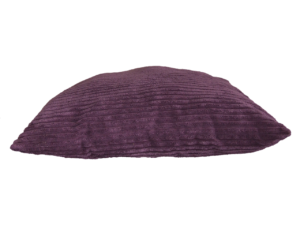
Practicing chest compressions on a pillow can help with understanding hand placement and the force needed to compress the chest.
However, pillows lack the resistance and feedback that a real chest or a CPR dummy would provide, making it difficult to gauge the correct depth of compressions.
Cushions are another viable alternative.
They tend to be firmer than pillows and can offer slightly more resistance.
This can make chest compressions feel a bit more realistic.
However, the same limitations apply—cushions do not provide the necessary feedback to ensure compressions are deep enough, nor do they accurately simulate the chest’s recoil.
Rolled-up towels can also be utilized for CPR practice.
By rolling several towels together, a more compact and firm surface can be created.

This method can better simulate the density of the human chest, providing a more realistic practice experience as you go to – Practice CPR Without a Dummy.
The main drawback is that towels, like pillows and cushions, still lack the ability to simulate the chest’s rebound, which is crucial for effective CPR.
These household items, while imperfect, offer affordable and accessible alternatives for CPR practice.
They can help individuals become familiar with the basic mechanics of chest compressions, hand placement, and the rhythm required during CPR.
However, for a more comprehensive and realistic training experience, using a professional CPR dummy or attending a certified CPR course is recommended.
Practicing Chest Compressions
– Practice CPR Without a Dummy
Practicing chest compressions without a dummy requires a methodical approach to ensure accuracy and effectiveness.
To begin, proper hand placement is crucial.
Position the heel of one hand at the center of the chest, directly on the lower half of the sternum, while placing the other hand on top and interlocking the fingers.
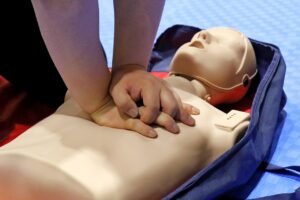
This ensures that the force is concentrated on the correct area.
Next, consider the amount of force applied.
It is essential to use your body weight to perform compressions rather than just your arm strength.
Lean forward so that your shoulders are directly over your hands.
This positioning helps to apply the necessary pressure to reach a compression depth of about 2 inches (5 cm).
Remember, the key is to press hard and fast, but also allow the chest to recoil completely between compressions to maximize the effectiveness.
Maintaining the proper compression rate is another critical aspect.
The recommended rate is 100 to 120 compressions per minute.
To assist with rhythm, using a metronome can be highly beneficial.
Alternatively, practicing to the beat of a song with a tempo of 100 to 120 beats per minute, such as “Stayin’ Alive” by the Bee Gees, can help maintain consistency.
This auditory aid ensures that you are adhering to the optimal compression rate, which is vital in a real-life scenario.
Practicing these techniques regularly, even without a dummy, can significantly enhance your proficiency in performing chest compressions.
Focus on correct hand placement, applying the appropriate amount of force, and maintaining a consistent rhythm.
These elements collectively contribute to the effectiveness of chest compressions.
Ultimately improving the chances of success in actual CPR situations.
Practicing Rescue Breaths
Practice CPR Without a Dummy
Practicing rescue breaths is a critical component of Cardiopulmonary Resuscitation (CPR).
While a dummy is the most effective tool for practicing, alternatives such as a sealed plastic bag or a balloon can be utilized to simulate the action effectively.
The focus here is on mastering the technique and ensuring that the airway is open, which is vital for the success of rescue breaths.
To practice using a sealed plastic bag or a balloon, begin by taking a deep breath and then sealing your lips around the opening of the bag or balloon.
Pinch the “nose” of the bag or balloon to mimic the action of sealing a person’s nose.
Exhale steadily and watch for the bag or balloon to inflate.
This simulates the chest rise you would see in a real person.
Repeat this process to ensure you are delivering consistent and effective breaths.
The correct technique involves several crucial steps.
Firstly, ensure the airway is open by tilting the head back and lifting the chin.
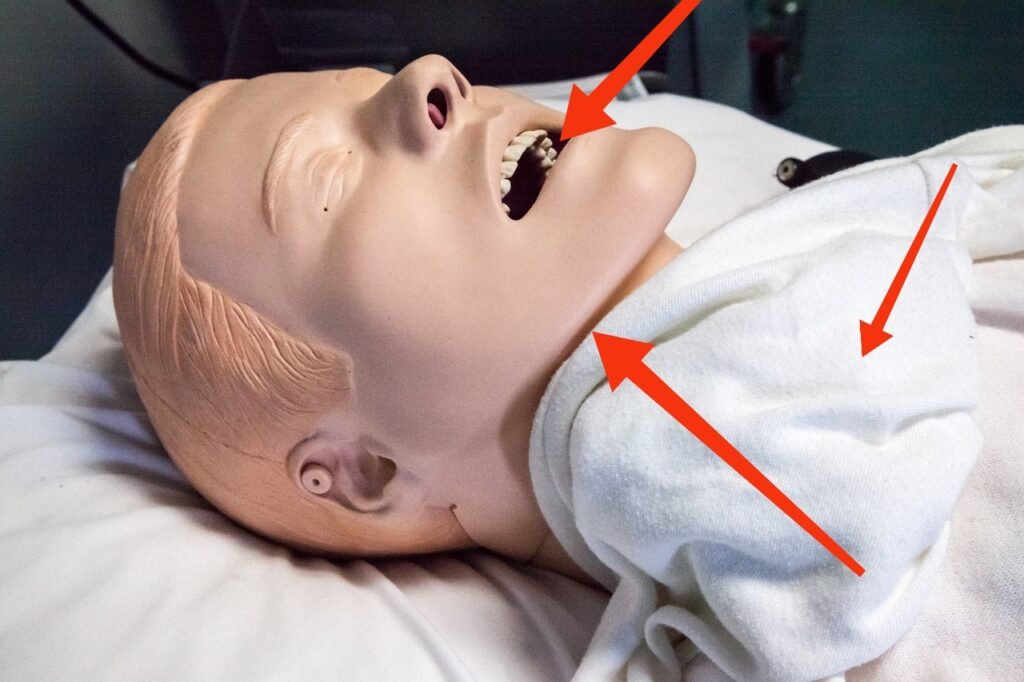
This action helps to prevent the tongue from obstructing the airway.
Next, deliver a breath that lasts about one second and observe for the chest to rise, indicating that air is entering the lungs.
Make sure not to overinflate, as this can lead to complications such as gastric inflation.
After the first breath, allow the chest to fall completely before delivering the second breath.
Common mistakes to avoid during rescue breaths include not maintaining a proper seal.
That can lead to air escaping, and not tilting the head back adequately.
Which can result in an obstructed airway.
Additionally, avoid blowing too forcefully or too quickly, as this can cause air to enter the stomach instead of the lungs.
Practicing with alternatives like a sealed plastic bag or balloon helps to develop a sense of the correct pressure and volume needed for effective rescue breaths.
By consistently practicing these techniques and paying attention to common pitfalls.
You can significantly improve your ability to perform rescue breaths correctly, which is a vital skill in emergency situations.
For your safety Practice CPR Without a Dummy so you can build confidence on the skill.
Simulating a Real-Life Scenario
Practicing CPR without a dummy can be effectively done by simulating real-life scenarios.
To achieve this, one method involves role-playing with a friend or family member.
This not only helps in understanding the practical aspects of CPR but also in managing the stress and urgency of an actual emergency.
Assign roles beforehand, where one person acts as the victim and the other as the responder.
This approach helps you to get accustomed to the dynamics of a real situation.
Using a stopwatch is another crucial element in your practice.
Timing the compressions and breaths accurately is vital for the effectiveness of CPR.
The current guidelines recommend 30 chest compressions followed by 2 rescue breaths.
The compressions should be delivered at a rate of 100 to 120 per minute.
Practicing with a stopwatch will help ensure you maintain the correct rhythm and timing, which can be lifesaving in a real emergency.
Additionally, practicing in different settings can enhance your preparedness.
Emergencies can occur in various environments.
So it is beneficial to simulate scenarios in diverse locations such as the living room, kitchen, or even outdoors.
This variety will help you adapt to different spaces and obstacles.
Making your practice sessions more comprehensive and realistic.
Incorporate different emergency situations into your practice.
For instance, practice responding to a scenario where the victim is lying on a bed versus on the floor.
Each situation will present unique challenges that can help sharpen your skills and improve your ability to respond effectively.
By combining role-playing, precise timing with a stopwatch, and practicing in varied settings, you can create a realistic and effective practice regimen for CPR.
This holistic approach ensures you are well-prepared to handle real-life emergencies with confidence and competence.
Using Online Resources and Apps
Practice CPR Without a Dummy
In today’s digital era, technology has revolutionized the way we learn and practice essential skills, including CPR.
When practicing CPR without a dummy, online resources and mobile apps can serve as invaluable tools, offering comprehensive virtual training and real-time feedback.
One of the primary benefits of utilizing online resources and apps for CPR training is the accessibility and convenience they offer.
Individuals can learn at their own pace, revisit complex concepts, and practice techniques as often as needed.
Additionally, many platforms provide visual and auditory cues, which mimic real-life scenarios.
Ensuring that learners can effectively apply their skills in emergency situations.
For those seeking reliable online resources, the American Heart Association (AHA) offers a range of courses and instructional videos on their official website.
Another notable platform is the Red Cross, which provides free CPR training videos and interactive modules that cover various aspects of first aid and emergency response.
Mobile apps have also emerged as powerful tools for CPR training.
Apps such as “Resuscitation! CPR AED” and “CPR Trainer” offer virtual simulations, performance tracking, and feedback mechanisms.
These apps, often developed in collaboration with medical professionals, ensure that the content is accurate and up-to-date.
By leveraging online resources and apps, anyone can gain the confidence and skills needed to perform CPR accurately, even without access to a physical dummy.
Conclusion and Encouragement to Seek Formal Training
Throughout this comprehensive guide, we have explored various methods and tips for practicing CPR without a dummy.
These techniques are invaluable for enhancing your familiarity with the fundamental steps of CPR, such as chest compressions and rescue breaths.
However, it is crucial to understand that practicing CPR without a dummy is only a supplementary exercise.
The intricacies of proper hand placement, compression depth.
CPR is a vital life-saving skill that can make a significant difference during emergencies.
The ability to perform CPR correctly can enhance the chances of survival for individuals experiencing cardiac arrest.
Therefore, while practicing the techniques discussed in this guide can help build confidence.
It should not replace formal training and certification.
Engaging in professional CPR courses provides comprehensive instruction,
practical experience, and the opportunity to receive feedback from qualified trainers.
We strongly encourage you to seek out formal CPR training and certification from recognized organizations.
such as the American Heart Association (AHA), the Red Cross, or local health departments.
These courses offer in-depth knowledge, hands-on practice.
Investing time in formal CPR training not only enhances your proficiency but also contributes to a safer community.
For those interested in furthering their skills and knowledge.
We have compiled a list of resources and links to local CPR courses and organizations offering certified training programs.
By taking the initiative to enroll in these courses.
Remember, while practicing CPR at home is a valuable exercise, formal training is indispensable.
Equip yourself with the skills and confidence.
On – Practice CPR Without a Dummy – share your thoughts.
Thanks


